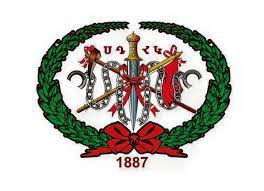Federation and Democracy Have Many Names

When politics and words cross paths, one of them is bound to cede. This is what happened with the words “federation” and “democracy” in Armenian.
In 1890 all Armenian revolutionary groups, including the newly founded Social Democrat Hunchakian Party (1887), came together to form the Federation of Armenian Revolutionaries (Հայ Յեղափոխականների Դաշնակցութիւն / Hay Heghapokhaganneri Tashnagtsootioon). However, when the alliance with the Hunchakian Party fell apart, the new political party changed its name into Armenian Revolutionary Federation (Հայ Յեղափոխական Դաշնակցութիւն / Hay Heghapokhagan Tashnagtsootioon).
In 1908, after the coup d’état of the Young Turks, a party of conservative leanings was founded in Constantinople, the Armenian Constitutional Democratic Party (Հայ Սահմանադիր Ռամկավար Կուսակցութիւն / Hay Sahmanatir Ramgavar Goosagtsootioon). This party would last until 1921. There was a short-lived National Democratic Party (Ազգային Ռամկավար Կուսակցութիւն – Azkayin Ramgavar Goosagtsootioon) founded in 1919, and then, in 1921, the Constitutional Democratic party joined other parties into the creation of the Democratic Liberal Party (Ռամկավար Ազատական Կուսակցութիւն / Ramgavar Azadagan Goosagtsootioon).
As anyone familiar with Armenian issues knows, both the Armenian Revolutionary Federation and the Democratic Liberal Party exist today. The former is known in brief as Tashnagtsootioon (Դաշնակցութիւն) “Federation,” and the latter, as Ramgavarner (Ռամկավարներ), namely, “Democrats.”
The word դաշնակից (tashnagits) is composed by the terms դաշն (tashn, “harmonious”) and կից (gits) , root of the verb կցել (gtsel “to join”), which yield the basic meaning for “ally” (the Allied side in both world wars was called tashnagits in Armenian). Then, tashnagtsootioon could be used with both meanings “alliance” and “federation,” although the name of the party adopted the latter one.
Interestingly, the members of the party were designated with the adjective դաշնակցական (tashnagtsagan ), literally meaning “federal” or “federative.” Over time, this adjective was reserved to that exclusive use, and whenever the word “federal” or “federative” comes, the adjective դաշնակցային (tashnagtsayin) is used. A more extreme case happened in Eastern Armenian after the disintegration of the Soviet Union: the Russian loanword ֆեդերացիա (federatsia) “federation” was dropped from use. However, it was not replaced by the Armenian term tashnagtsootioon, but by a newly created word, դաշնութիւն (tashnootioon) , and the adjective “federal/federative” became դաշնային (tashnayin) Thus, the name of the Russian Federation was turned from Ռուսական Ֆեդերացիա ( Roosagan Federatsia) into Ռուսական Դաշնութիւն (Roosagan Tashnootioon), and, for good or worse, it entered Western Armenian usage (where it was Roosagan Tashnagtsutioon before). The expression “federal government” became դաշնային կառավարութիւն (tashnayin garavarootioon).
However, it is intriguing that the Football Federation of Armenia was called Հայաստանի Ֆուտբոլի Ֆեդերացիա (Hayastani Footboli Federatsia), and for some reason the word tashnootioon was left aside.
In the case of ramgavar, we also deal with a literal translation derived from the Greek roots demos (“common people”) and kratia (“rule”). However, over time, the word and its derivation ռամկավարութիւն ( ramgavarootioon ) “democracy” were reserved for its exclusive use for anything related to the party. Today the word “democratic” (and the related “democrat”) has become another literal translation from the same Greek roots: ժողովրդավար (zhoghovurtavar ), from ժողովուրդ (zhoghovoort “people”) and վար (var “rule”). There are two exceptions to this rule, again to avoid confusion:
- a) The Hunchakian Party continues using the original foreign words in its name, Սոցիալ Դեմոկրատ ( Sotsial Demokrat “Social Democrat”);
- b) The name of the Democratic Party of the United States—and sometimes its namesakes in other countries—is translated as Դեմոկրատ ( Demokrat “Democrat”) into Armenian, where it is not an epithet as in English.
As a funny anecdote, it is worthy to mention the case of the Transcaucasian Democratic Federative Republic, which joined Armenians, Georgians, and Tatars (the future Azerbaijanis) from April-May 1918, right before the independence of the first Republic of Armenia. In his famous book on the history of the latter, Simon Vratzian (1882-1969), its last prime minister, translated the name of that short-lived Transcaucasian republic as Անդրկովկասի Ռամկավար Դաշնակցական Հանրապետութիւն (Anturgovgasi Ramgavar Tashnagtsagan Hanrabedootioon). Someone who read those words and did not know their meaning might think that it was a republic founded by Ramgavars and Tashnagtsagans…
